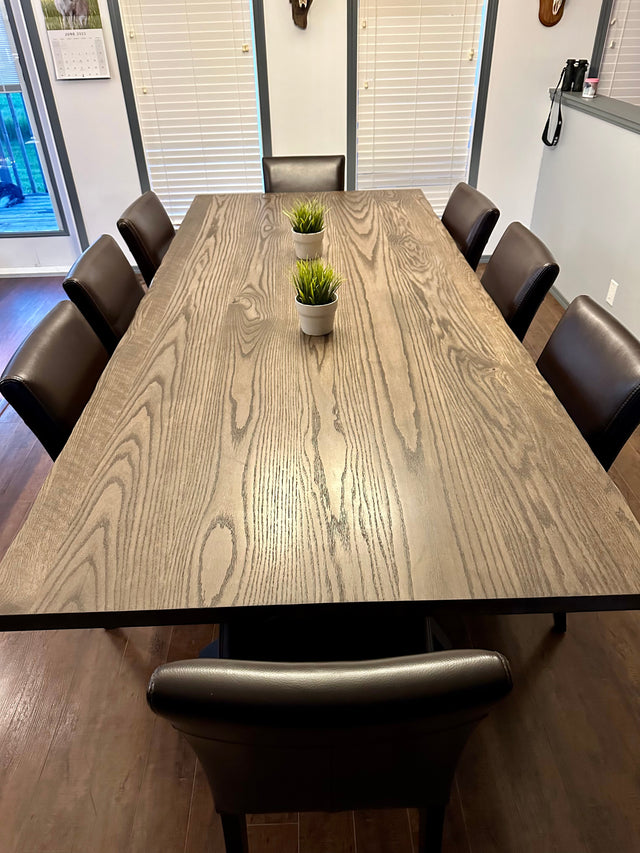How to Match Wood Patterns to Your Space
How to Match Wood Patterns to Your Space: The Unexpected Art of Custom Wood Furniture
When you think about furniture for your home, what’s the first thing that comes to mind? Comfort? Style? Maybe function? But what about the wood? Not all wood is created equal, and choosing the right wood grain can elevate your space in ways you might not expect. At YEG Woodcraft, we’ve mastered the art of matching wood patterns to different design aesthetics, and we’re here to guide you on how to bring out the unique beauty of your space through custom wood furniture.
The Unexpected Power of Wood Grain
When it comes to interior design, most of us focus on paint colors, furniture arrangements, and the latest trends. However, wood grain—whether it’s rich walnut, light maple, or sturdy oak—has the power to transform an entire room. The natural patterns found in the wood can add texture, depth, and movement to any space. Think of it as the secret ingredient in your home’s recipe, one that adds a layer of elegance or warmth you might not have considered before.
Step 1: Understand Your Wood Options
Let’s start with the basics. Every type of wood has its own unique pattern, which can dramatically affect the vibe of your space. Here are a few to consider:
- Walnut: A dark, rich wood with a pronounced grain pattern that brings a luxurious, sophisticated touch. Perfect for modern, minimalist designs or dramatic statement pieces.
- Maple: Light and airy with a smooth grain pattern. This versatile wood works well in both contemporary and rustic spaces, bringing a clean, fresh aesthetic.
- Oak: Strong and timeless, oak has a prominent grain that can fit into almost any style, from traditional to industrial. It’s perfect for larger furniture pieces that anchor the room.
Step 2: Match Your Wood to Your Room’s Personality
Once you understand your options, the next step is to match the wood to your room’s unique personality. Here are some unexpected pairings that work:
-
Industrial Loft Meets Warm Walnut: Pairing a warm, dark walnut wood with a more industrial, raw aesthetic creates an unexpected contrast that works surprisingly well. Think walnut shelves on exposed brick walls or a walnut coffee table set against a steel-framed sofa. It’s the perfect balance of raw and refined.
-
Cozy Cottage Meets Light Maple: The warmth of maple wood in a cottage or farmhouse setting creates a soft, welcoming atmosphere. The pale, uniform grain of maple blends well with soft pastels and natural fibers like linen and wool. Add in some antique-style hardware, and you’ve got a cozy, timeless look.
-
Scandi-Chic Meets Oak: Light oak works beautifully in Scandinavian-inspired spaces, with its clean lines and subtle grain. Its natural light color adds warmth without overwhelming a minimalist aesthetic. Try a custom oak dining table paired with neutral tones, and you'll have a serene and functional gathering space.
Step 3: Consider the Room’s Functionality
It’s not just about aesthetics; the room’s function plays a role in the wood selection too. Some woods handle wear and tear better than others, and choosing the right one can make a significant difference:
-
Durable Oak for High-Traffic Areas: If you’re looking for a floor or table in a high-traffic space like the kitchen or living room, oak’s durability makes it an excellent choice. Its hearty structure can withstand daily use, while its warm tones complement any décor.
-
Maple for Subtle Sophistication: Maple’s smooth texture and fine grain make it a fantastic choice for furniture in spaces that need a touch of elegance without being too bold. Consider it for your bedroom, where it can provide a peaceful, calming effect.
-
Walnut for Statement Pieces: If you want to make a bold statement, walnut furniture is the way to go. The darker tones and striking grain pattern make it a showstopper, whether it's a custom-made walnut cabinet in your entryway or a walnut dining table that sets the tone for your dining room.
Step 4: Play with Customization
One of the most exciting aspects of custom wood furniture is that it allows you to play with the grain. At YEG Woodcraft, we specialize in creating pieces that align with both your aesthetic preferences and functional needs.
-
Mixing Grains for Depth: While it may seem like mixing different wood grains is a no-go, in reality, it can create a stunning, layered look. Consider mixing walnut and oak for a dynamic design that adds depth and interest to your living room or dining area.
-
Add a Twist with Non-Traditional Patterns: Wood doesn’t always have to follow the traditional straight grain pattern. If you’re feeling adventurous, ask your designer about custom cuts and non-traditional patterns, like cross-cut designs, that can add unexpected flair to your space.
Step 5: Work with Your Space’s Lighting
The way light interacts with your wood choice can change the entire vibe of a room. Light woods like maple can brighten up a space and give it a fresh feel, while dark woods like walnut can create an intimate, cozy atmosphere when paired with low lighting. Think about the amount of natural light your space receives and choose wood that complements that light for a cohesive, balanced feel.
In Conclusion: Trust Your Instincts
Choosing the right wood grain for your space isn’t just about following trendsit’s about finding a material that resonates with your style and functionality needs. Whether you prefer the warmth of walnut, the freshness of maple, or the timeless appeal of oak, matching the wood grain to your space can make all the difference.

